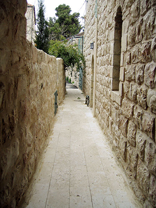Rabbi David ben Shimon was an illustrious leader who lovingly and devotedly headed the North African Jewish community within the Old City of Jerusalem and outside of it.
Jerusalem of old was still the heart of the nation at a time when Jews were scattered in the Diaspora. The Spanish Expulsion caused hundreds of Spanish Jews to turn to the Holy Coty for refuge, and the Spanish Jewish community in Jerusalem grew steadily until it became the largest community in the Holy City in the middle of the 18th century. During that time, a large wave of immigrants from Islamic countries and from the Ottoman Empire began arriving in Jerusalem, among them Rabbi David ben Shimon, who is also referred to as the 'Radvash' or the 'Tzuf Devash'.
Rabbi David ben Shimon came from the city of Rabat, Morocco, where he was born in the year of 5584. He arrived in Jerusalem together with his son Rabbi Rafael Aharon and his disciples. Rabbi David's father was a respectable and wealthy merchant in Morocco. Rabbi David's extraordinary personality and unique character became evident at a very young age, and he quickly became a leading figure within the Moroccan Jewish community, attracting hundreds of pupils who drank his words of Torah with immense thirst.
At the age of twenty eight, Rabbi David left Morocco for Jerusalem, and upon seeing the horrific conditions in which his Jewish brethren lived in the Holy City, he immediately decided to improve their lives and they, in turn, asked him to become their leader.
 |
| Sir Moses Montefiore [] |
 |
| the Scenery is a Portrait on a Street Wall [צלם] |
 |
| the Neighborhood [צלם] |
A heavy responsibility was thrust upon the shoulders of Rabbi David at that moment; the community of immigrants from Arab counties was unorganized and unstructured. Rabbi David established the 'Edah HaMaaravit B'Yerushalayim' for Jews from North African countries. The community, alongside all other Sephardic communities, was under the auspice of the umbrella organization "Ha'Edah HaSfaradit B'Yerushalayim'.
 |
| [צלם] |
 |
| Passageway with staircase in neighborhood [צלם] |
Rabbi David's idea to form a separate community for immigrants from North Africa was an innovation and somewhat of a daring deed as all other Sephardic communities were directly under the leadership of the "Edah HaSfaradit B'Yerushalayim' and Rabbi David's community was the first to break off from its direct supervision.
Yet another innovative idea was to send Shadars (messengers who collect money for Torah institutions in the Holy land) to Jewish communities in Islamic countries in order to raise funds for the community and its institutions. Rabbi David also needed resources to fund the new community which he was in the midst of establishing outside the walls of Old City, and to improve the conditions of the community members who lived within the Old City.
Rabbi David was a great advocator for the needy and opened a meat store where he would distribute meat to the poor. His house was constantly open for the needy, and the members of his community would affectionately call him 'avi ha'yetomim v'dayan ha'almanot' – 'father of the orphans and advocator of the widows'.
In order for his community members to be informed on all monetary matters of the community, he would publish all expenses and donations made to the community in a special newspaper called 'Havatzelet'.
Rabbi David personally led the community for six years, however as the community expanded and its needs increased, he appointed a committee of seven rabbis who would assist him in leading the community. Sir Moses Montefiore also greatly assisted the community.
Rabbi David, aside from his administrative role, also served as Rosh Yeshiva, rabbi and posek, and gave halachic rulings in his Beth Din.
Rabbi David's idea to create a Jewish community outside the walls of the Old City necessitated large funds and much courage. With the help of donations from abroad he purchased a lot outside the walls, which he called 'Machane Yisrael'. There he established two synagogues, several Batei Medrash (houses of study), mikvahs and shelters for the needy. The gates of the community were closed at night. 'Machane Yisrael' was the second community to be established outside the walls of the old city, and was often referred to as 'the neighborhood of the Mugrabim (immigrants from North Africa)'.
Rabbi David's great love for the Promised Land filled his whole being, and it is that love that brought him to the Holy Land with a burning desire to build it, both spiritually and physically. His immense love for the land is also evident in his book 'Shaarei Tzedek', where he collected all commentaries of the Sages regarding the Holy Land and added commentaries of his own. He invested much time, effort and resources to publish his book and distributed it not only in the Hoy Land, but also abroad.
After his passing, several other books based on his writings were published, among them 'Shaar Hamatarah' on the laws of the land, 'Shaar Hamifkad' on the special traditions of the land, 'Shaar Takdim' on the commandments of the land and 'Shaarei Tehilah' which contains prayers and songs for special occasions.
Rabbi David's many achievements and his concern for each and every Jew led to countless of people thronging to his house to seek shelter and guidance. Many people from other communities sought his blessings and wished to learn Torah from his mouth. Although Rabbi David was extremely humble and modest, fame did not escape him and his name became wide known throughout the Holy land and beyond. He would never sign his name, but would merely write: 'A little Devash', and before he recorded his halachic rulings he would write: 'I acknowledge my lowliness and I have nothing to reply'.
Rabbi David ben Shimon passed away on the 20th of Kislev, 5640, and was laid to rest in the Mount of Olives in Jerusalem.











